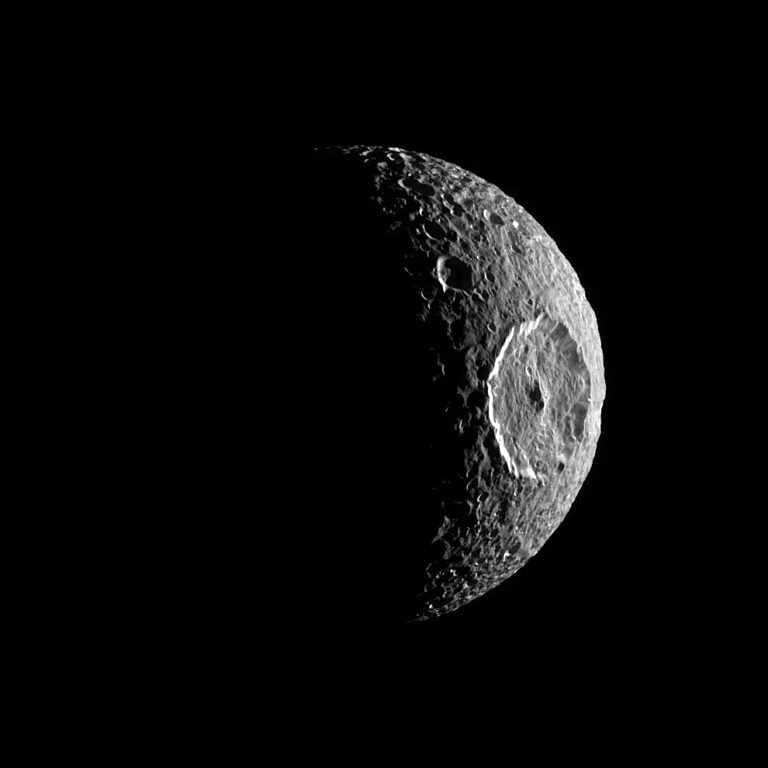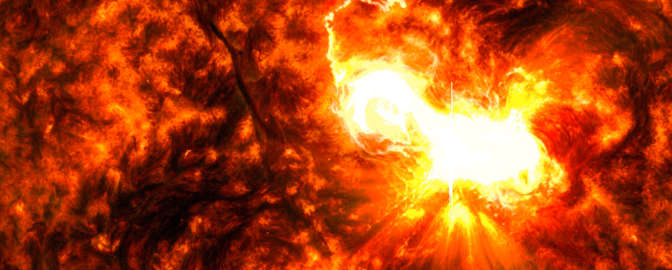The coolest moons of Jupiter and Saturn you’ve never heard of

Written by
Kate Howells
Public Education Specialist, The Planetary Society
February 5, 2024
At least 290 moons have been discovered in our Solar System. Their distribution among the planets is far from even; 240 of those moons orbit Jupiter and Saturn.
Of those 240 moons, some are better known than others. You’ve almost certainly heard of icy Europa and Enceladus, whose subsurface oceans may be hospitable to life. Jupiter’s Io is famous for its extreme volcanic activity. Saturn’s Titan holds a special place in the Solar System as the only place other than Earth with liquid seas, lakes, and rivers (of methane, though, not water). But the lesser-known moons are no less worth learning about.
Mimas
Saturn’s moon Mimas is special for two reasons. First, it’s the smallest object in the Solar System to be gravitationally rounded. And second, because of a giant crater, Mimas looks like the Death Star. Funnily enough, when George Lucas wrote the line ‘That’s no moon ... it’s a space station’, in 1977’s “Star Wars: Episode IV – A New Hope,” Mimas had not yet been observed closely enough to see what it looked like. The first missions to get close-up images of Mimas were NASA’s Voyager 1 and 2 in 1980 and 1981.

The Amalthea group
Within the orbit of Jupiter’s innermost large moon, Io, are four smaller moons: Metis, Adrastea, Amalthea, and Thebe. They are known as the Inner Group, or the Amalthea group after their largest member, which measures 270 kilometers (168 miles) at its longest.
Amalthea is the reddest object in the Solar System, possibly because of sulfur being ejected by Io’s volcanoes. Amalthea also appears to radiate more heat than it receives from the Sun. According to NASA, this may be because electric currents are induced in the moon's core as it orbits within Jupiter's powerful magnetic field. It might also be generated by the same kind of tidal forces that make Io the volcanic world it is.
All four Amalthean moons orbit Jupiter at break-neck speed. Thebe goes around Jupiter in about 16 hours, and Amalthea in 12. Adrastea whips around the giant planet in only seven hours, and Metis in just five.
Adrastea and Metis orbit inside Jupiter's main ring and are likely the source of the ring’s material. Amalthea and Thebe shed material that creates Jupiter’s Gossamer ring.

Hyperion
Saturn’s moon Hyperion is unusual and interesting because of its sponge-like appearance. It looks this way because about 40% of the moon is just empty space. It is highly porous, with pockets of nothingness throughout it.
One possible explanation is that Hyperion is made from smaller objects that came together gravitationally but never got big enough to fuse into one solid object, much like a rubble pile asteroid. Hyperion is the largest object in the Solar System with an irregular shape. It’s larger in diameter than Mimas, but because it’s so porous, Hyperion doesn’t have enough mass to become round.

Himalia
Himalia is the brightest of Jupiter's outer moons, and the fifth-largest moon in that planet’s system. That doesn’t make it big though; its average diameter is only 170 kilometers (106 miles), compared to the fourth-largest moon Europa whose diameter is over 3,120 kilometers (1,940 miles).
Like many of Jupiter’s smaller moons, Himalia is thought to be an asteroid that was captured by Jupiter’s gravity. It is also the namesake of a group of asteroids that are thought to have originally been part of that former asteroid before breaking apart in a collision. The other moons in the Himalia group are Leda, Lysithea, and Elara.

Pan
Pan is the innermost of Saturn’s named moons, and bears an adorable resemblance to some kind of dumpling (or pierogi, empanada, ravioli, or whatever doughy pocket you’d like). It’s also known as a ring shepherd, because it keeps one of the gaps between Saturn’s rings clear of particles.
The reason Pan has its dumpling shape is likely because of its shepherd role. Pan’s orientation as it moves through space makes it so that loose ring material it picks up settles on its surface around its equator. It’s also possible that it got this shape when two even smaller moonlets crashed into each other and merged, creating a ridge where they combined.

Iapetus
Similar to Mimas, Saturn’s third-largest moon Iapetus has a huge impact crater that makes it look a little Death Star-esque. But what makes Iapetus really interesting is the stark difference between its two hemispheres.
On the side with the crater, Iapetus is bright white with a few dark speckles. On the opposite side, it’s almost completely covered in a dark substance. One initial explanation for this disparity was that the dark material is on the moon’s leading side. Iapetus is tidally locked to Saturn, so one side always faces forward as it moves through space. But if this were the explanation, you’d expect to see this on other moons that are tidally locked to their host planet.
Another possibility is that Iapetus is colored by material ejected from Saturn’s small, dark moon Phoebe. Another theory is that Iapetus’ split appearance reinforces itself due to heat. If, at some point in the past, Iapetus had become covered in dark material, that could have set in motion a pattern of heating. The darker side might absorb more heat than the lighter side, making it warm up and melt any remaining ice — it would get even darker, absorb more light, and so on.

Rhea
Saturn’s second-largest moon is Rhea. It is also the only moon we’ve ever found with a set of rings around it.
The evidence for Rhea’s ring isn’t conclusive yet. NASA’s Cassini spacecraft’s instruments were looking at Saturn’s magnetic field and found that it was being affected by something around Rhea, an effect that would most likely be explained by the presence of a ring. Cassini was never able to get direct images of the ring, though.
Another hint that Rhea might have rings – or might have had rings in the past – is that there is a chain of blueish material all around its equator, which could have come from ring material settling onto the surface.

S/2003 J 12
Last but not least is Jupiter's smallest known moon, simply called S/2003 J 12. With an estimated diameter of only about 1 kilometer (0.6 miles), it is the smallest known moon in the Solar System.
S/2003 J 12 was discovered in 2003, but then promptly lost. This happens when a newly discovered moon’s orbital path is not well understood enough for follow-up observations to track it. The tiny moon was rediscovered by amateur astronomer Kai Ly in 2020.
Earth's First Line of Defense
Support the team of astronomers defending Earth with a gift today.
Donate

 Explore Worlds
Explore Worlds Find Life
Find Life Defend Earth
Defend Earth

